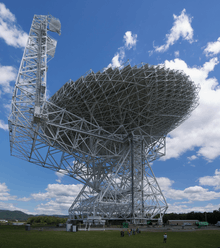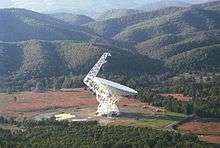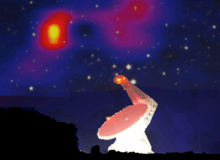Green Bank Telescope
 The Green Bank Telescope | |
| Location(s) | Green Bank, Pocahontas County, US |
|---|---|
| Coordinates | 38°25′59″N 79°50′23″W / 38.433055555556°N 79.839722222222°WCoordinates: 38°25′59″N 79°50′23″W / 38.433055555556°N 79.839722222222°W |
| Observatory code | 256 |
| Built | 1991–2002 |
| First light |
22 August 2000 |
| Telescope style |
Gregorian telescope Off-axis illumination radio telescope |
| Diameter | 100 m (328 ft 1 in) |
| Collecting area | 2.3 acres (100,000 sq ft) |
| Focal length | 60 m (200 ft) |
| Website |
greenbankobservatory |
 Location of Green Bank Telescope | |
The Robert C. Byrd Green Bank Telescope (GBT) in Green Bank, West Virginia, USA is the world's largest fully steerable radio telescope.[1] The Green Bank site was part of the National Radio Astronomy Observatory (NRAO) until September 30, 2016. Since October 1, 2016, the telescope has been operated by the newly created Green Bank Observatory.[2] The telescope honors the name of the late Senator Robert C. Byrd who represented West Virginia and who pushed the funding of the telescope through Congress.
The Green Bank Telescope operates at meter to millimeter wavelengths. Its 100-meter diameter collecting area, unblocked aperture, and good surface accuracy provide superb sensitivity across the telescope's full 0.1–116 GHz operating range. The GBT is fully steerable, and 85% of the entire celestial sphere is accessible. It is used for astronomy about 6500 hours every year, with 2000–3000 hours per year going to high-frequency science. Part of the scientific strength of the GBT is its flexibility and ease of use, allowing for rapid response to new scientific ideas. It is scheduled dynamically to match project needs to the available weather. The GBT is also readily reconfigured with new and experimental hardware. The high-sensitivity mapping capability of the GBT makes it a necessary complement to the Atacama Large Millimeter Array, the Expanded Very Large Array, the Very Long Baseline Array, and other high-angular resolution interferometers. Facilities of the Green Bank Observatory are also used for other scientific research, for many programs in education and public outreach, and for training students and teachers.
The telescope began regular science operations in 2001, making it one of the newest astronomical facilities of the US National Science Foundation. It was constructed following the collapse of a previous telescope at Green Bank, a 90.44 m paraboloid erected in 1962. The previous telescope collapsed on 15 November 1988 due to the sudden loss of a gusset plate in the box girder assembly, which was a key component for the structural integrity of the telescope.[3]
Location

The telescope sits near the heart of the United States National Radio Quiet Zone, a unique area located in the town of Green Bank, West Virginia, where authorities limit all radio transmissions to avoid emissions toward the GBT and the Sugar Grove Station. The location of the telescope within the Radio Quiet Zone allows for the detection of faint radio-frequency signals which man-made signals might otherwise mask. The observatory borders National Forest land, and the Allegheny Mountains shield it from some radio interference.
Description
The structure weighs 7,600 metric tons (8,400 short tons) and is 485-foot (148 m) tall. The surface area of the GBT is a 100 by 110 meter active surface with 2,209 actuators (small motors used to adjust the position) for the 2,004 surface panels, making the total collecting area of 2.3 acres (9,300 m2).[4][5] The panels are made from aluminium to a surface accuracy of better than 0.0076 mm or 0.003 inches (76 µm) RMS. The actuators adjust the panel positions to compensate for sagging, or bending under its own weight, which changes as the telescope moves. Without this so-called "active surface", observations at frequencies above 4 GHz would not be as efficient.[6]
Unusually for a radio telescope, the primary reflector is an off-axis segment of a paraboloid. This is the same design used in familiar home satellite television (e.g., DirecTV) dishes. The asymmetric reflector allows the telescope's focal point and feed horn to be located at the side of the dish, so that it and its retractable support boom do not obstruct the incoming radio waves, as occurs in conventional radio telescope designs with the feed located on the telescope's beam axis.
The offset support arm houses a retractable prime focus feed horn in front of the 8 m subreflector and eight higher-frequency feeds on a rotating turret at the Gregorian focus. Operational frequencies range from 290 MHz to 100 GHz.[6]
Because of its height (at 148 meters or 485 feet tall, it's 60% taller than the Statue of Liberty) and bulk (16 million pounds), locals sometimes refer to the GBT as the “Great Big Thing”.[7][8]
Discoveries

In 2002, astronomers detected three new millisecond pulsars in the globular cluster Messier 62.[9]
In 2006, several discoveries were announced, including a large coil-shaped magnetic field in the Orion molecular cloud,[10] and a large hydrogen gas superbubble 23,000 light years away, named the Ophiuchus Superbubble.[11][12]
Since 2006 numerous discoveries have been made, including the most massive neutron star detected so far, a cloud of primordial gas which surrounds other galaxies, vast molecular clouds surrounding other galaxies, and complex molecules, such as sugar, in space.
Engineering priorities
To maintain the parabolic shape and thus the best reception quality, the generic design of the antenna has to be structurally sound. In addition to weight, also temperature changes and wind loads need to be considered. The surface is made of reflecting panels, which need to be accurately placed, well-aligned and with high surface accuracy.[13] The capabilities of all radio telescopes are determined also by the instrumentation developed by the engineering staff.
Funding threatened
The National Science Foundation (NSF) Astronomy Portfolio Review committee chaired by Daniel Eisenstein of Harvard University recommended in August 2012 that the Robert C. Byrd Green Bank Telescope should be defunded over a five-year period.[14]
In the fiscal year 2014 budget, the US Congress did not recommend divesting the Green Bank Telescope. The Telescope is looking for partners to help fund its $10 million annual operating costs.[15]
As of October 2016, the Green Bank Observatory has begun separation from the NSF and accepting funding from private sources to stay operational.[16]
Relation to Breakthrough Listen
The telescope will scan for radio signals, possibly emitted by extraterrestrials, in the range of 1–10 GHz, a so-called "quiet zone" uninterrupted by man-made or natural sources. This immense undertaking is for the heavily funded Breakthrough Listen.[17]
See also
| Wikimedia Commons has media related to Green Bank Telescope. |
References
- ↑ Benningfield, Damond (June 2016). "SETI Gets an Upgrade". Air & Space/Smithsonian. National Air and Space Museum. Retrieved May 27, 2016.
- ↑ "NRAO Structural Changes: Announcing the Separation of the Green Bank Observatory and the Long Baseline Observatory, Associated Universities, Inc.".
- ↑ NRAO 300 foot Telescope Collapse
- ↑ "Robert C. Byrd Green Bank Telescope". The National Radio Astronomy Observatory. 9 August 2011. Archived from the original on 9 August 2011.
- ↑ Frayer, David. "Proposing for the GBT". The National Radio Astronomy Observatory. Retrieved 1 November 2016.
- 1 2 "The Proposer’s Guide for the Green Bank Telescope" (PDF). NRAO.
- ↑ Jim Merithew, “Silence! The Last of the Giant Radio Telescopes Is Listening to the Universe”, Wired (October 2009)
- ↑ John M Thompson, “W.Va. Observatory Scans the Universe for Radio Signals”, The Washington Post (19 November 2008)
- ↑ "Newly Commissioned Green Bank Telescope Bags New Pulsars". NRAO. 2002-01-04.
- ↑ Green Bank Telescope scores big finds in space: Fastest pulsar Slinky magnetics superbubble of hydrogen ID, The Charleston Gazette, 2006-01-17
- ↑ The Ophiuchus Superbubble: A Gigantic Eruption from the Inner Disk of the Milky Way, ArXiv
- ↑ "Huge 'Superbubble' of Gas Blowing Out of Milky Way". PhysOrg.com. 2006-01-13. Retrieved 2008-07-04.
- ↑ Li, Fu. "Surface Accuracy Analysis of Single Panels for the Shanghai 65-M Radio Telescope" (PDF). Transactions on applied and theoretical mechanics. World Scientific and Engineering Academy and Society (WSEAS). Retrieved 2016-07-28.
- ↑ Hand, E. (2012). "US telescopes face up to agency cuts". Nature. 488 (7412): 440. Bibcode:2012Natur.488..440H. PMID 22914143. doi:10.1038/488440a.
- ↑ Bumgardner, Bryan. "Too Big to Fail? The Green Bank Telescope's Uncertain Future". Scientific American. Retrieved 2013-09-04.
- ↑ Scoles, Sarah. "What Happens When a Space Observatory Goes Rogue". Wired. Retrieved 2016-10-07.
- ↑ "A Russian Tycoon is Spending $100 Million to Hunt for Aliens".